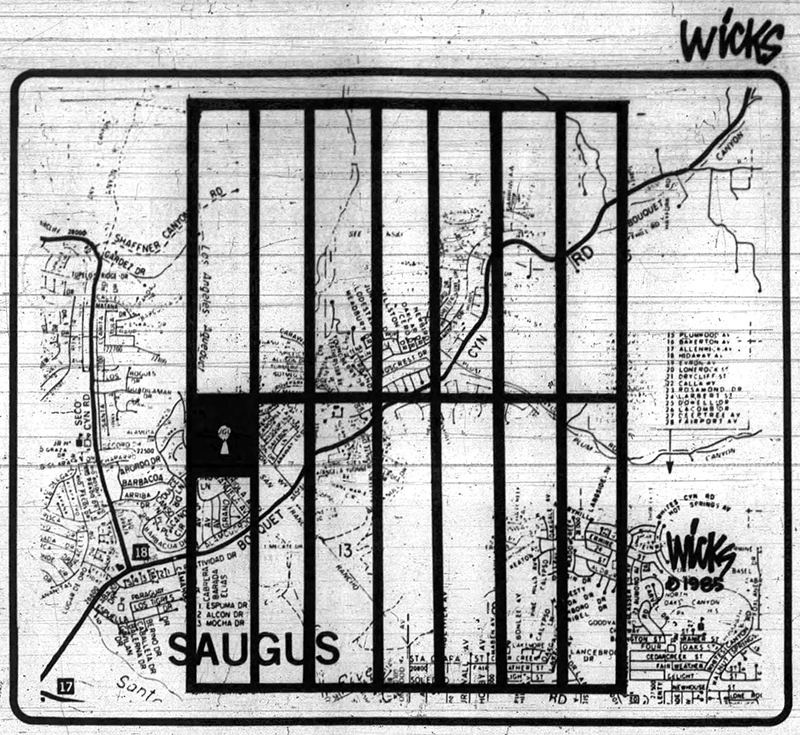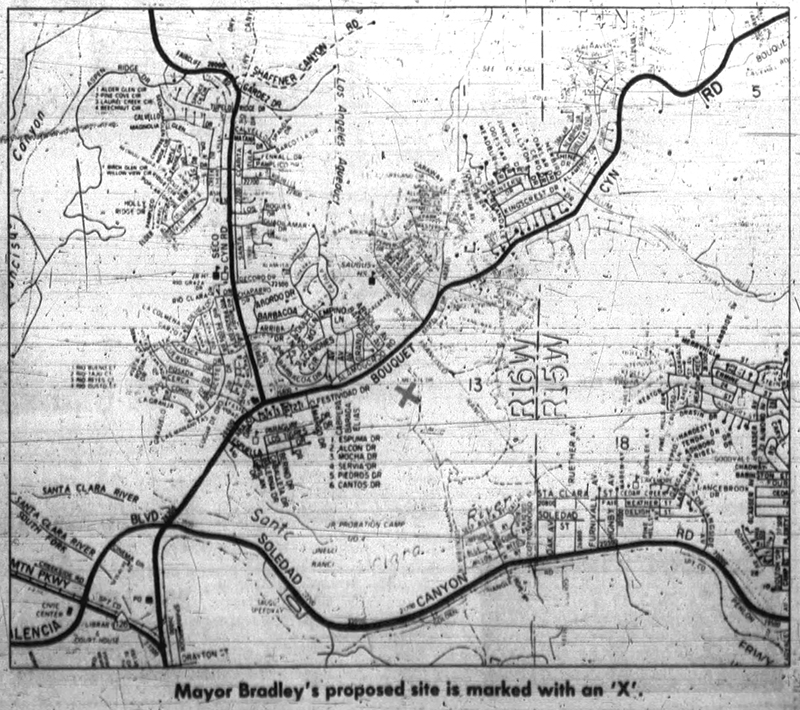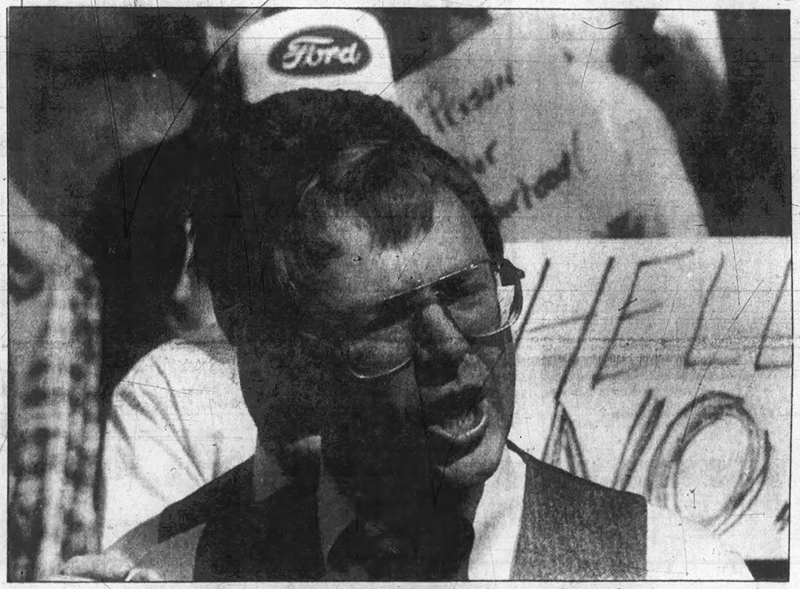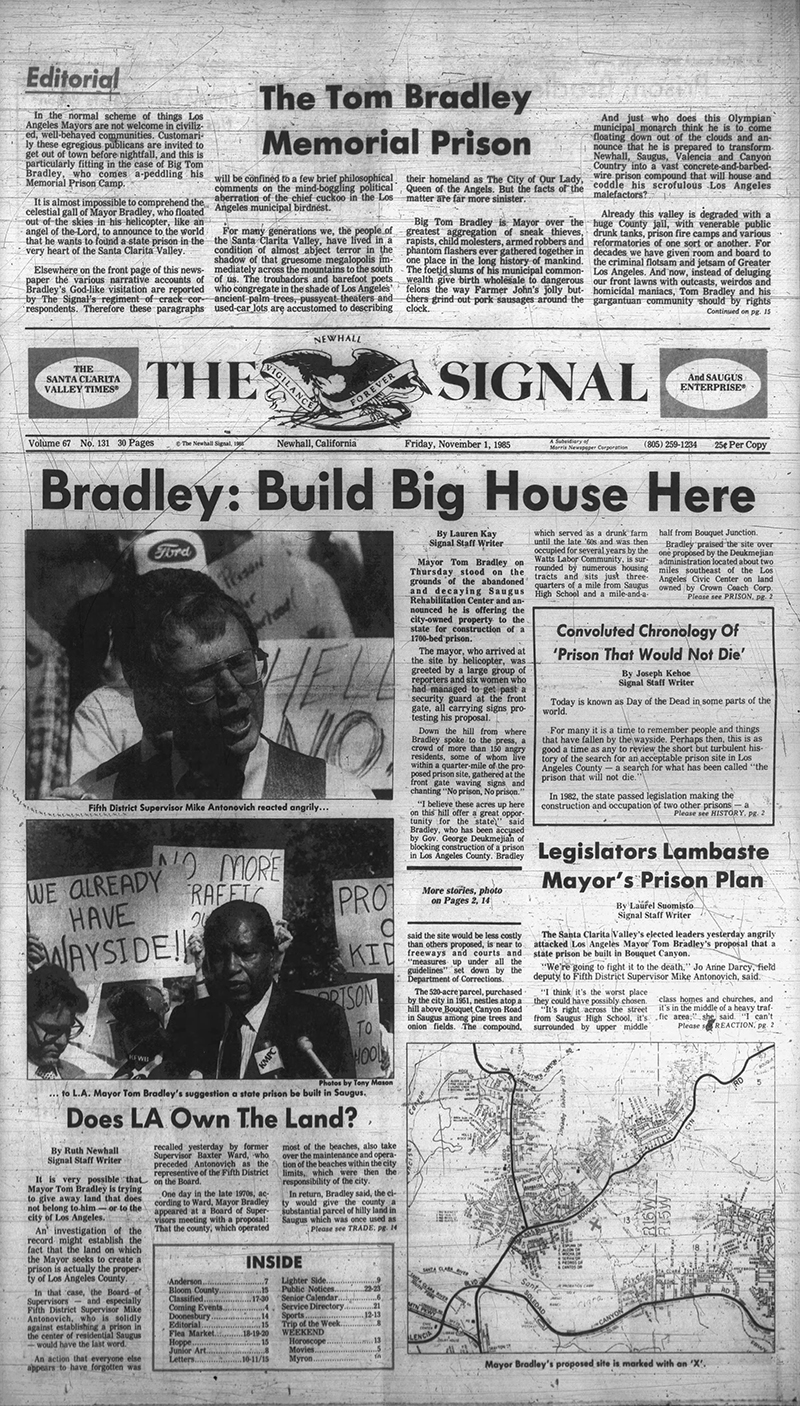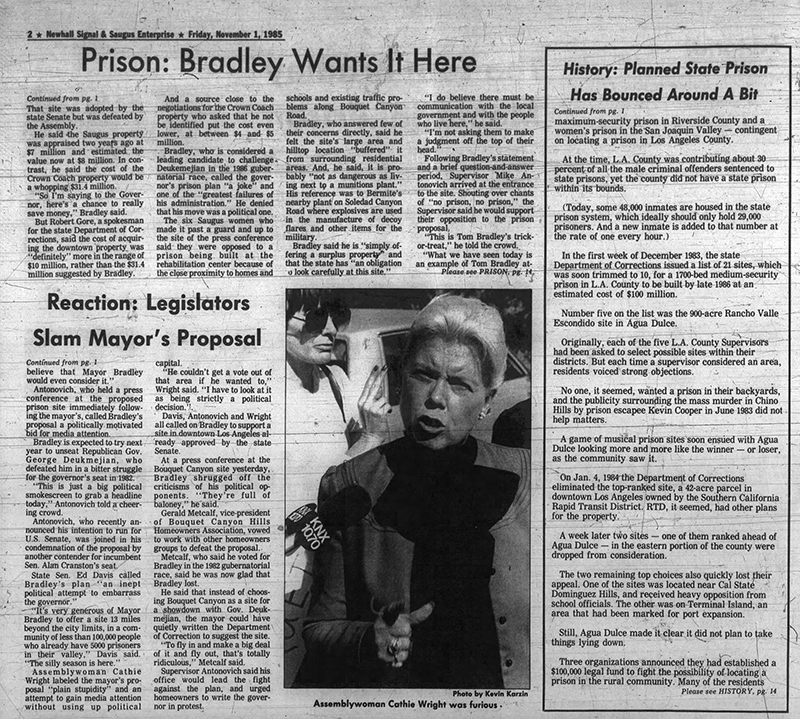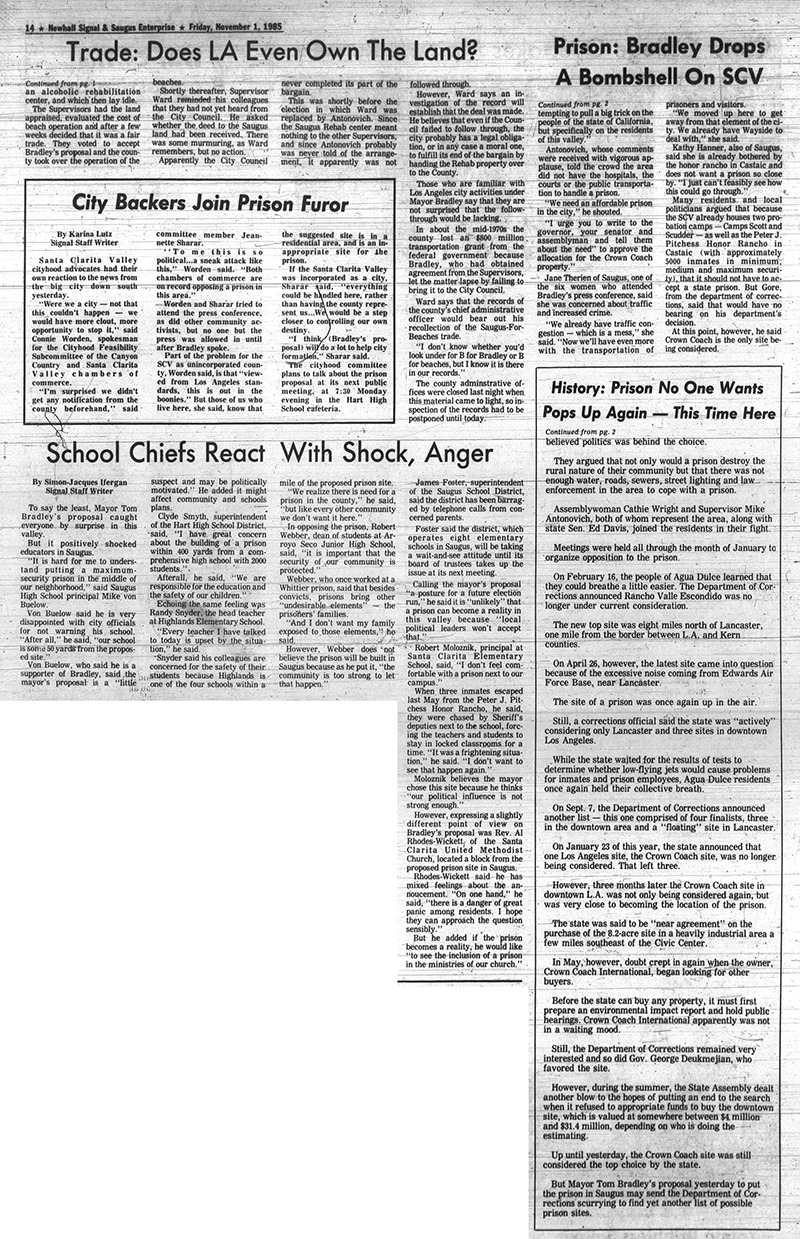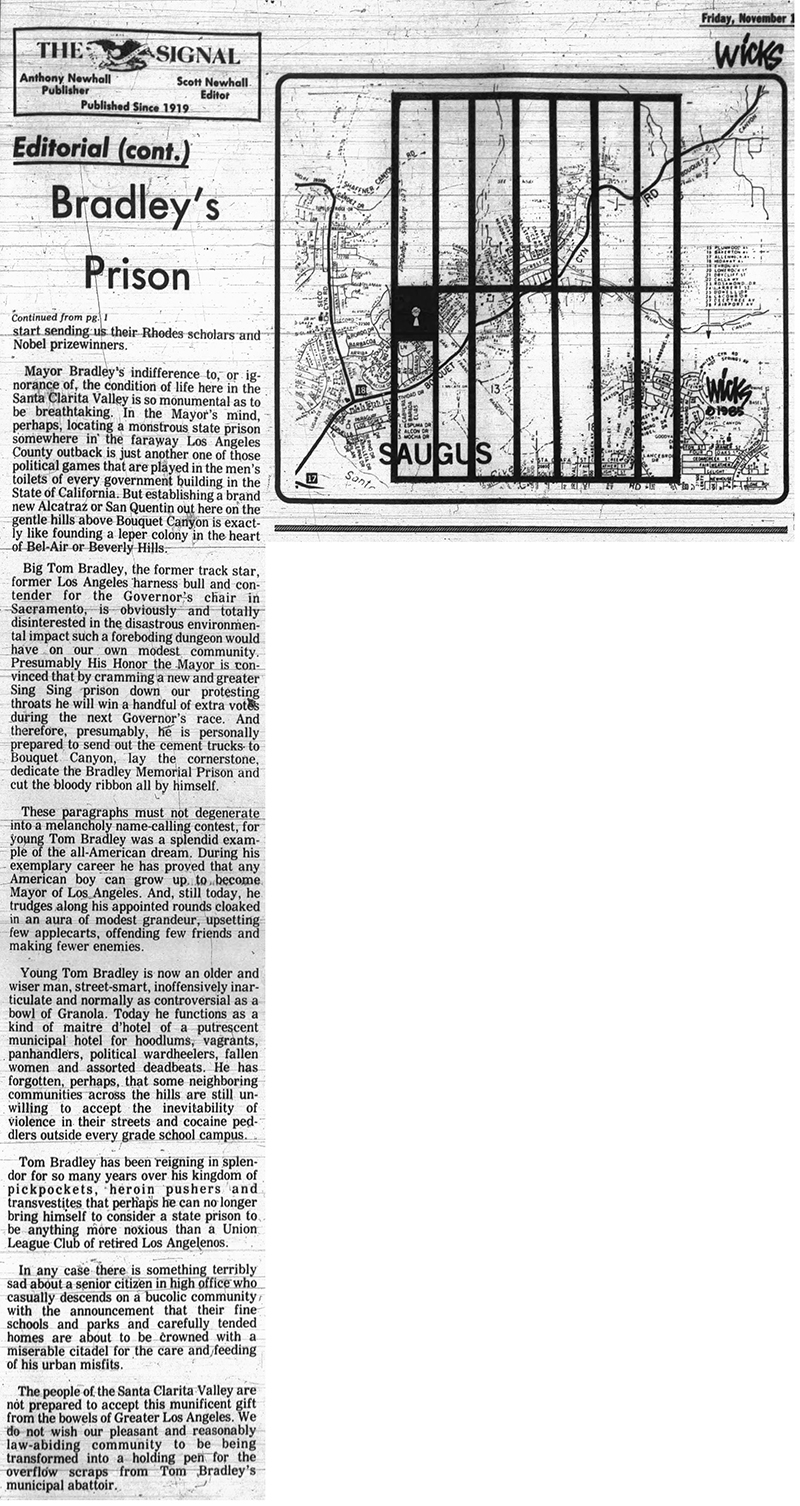|
|

L.A. Mayor's Saugus State Prison Plan Fans Flames of Cityhood.
The Signal, November 1, 1985.
The Los Angeles Times, November 5, 1985.
|
Webmaster's note.
It was the perfect setup for The Signal's firebreathing editorialist: L.A. Mayor Tom Bradley decided he'd meet L.A.'s obligation to host a state prison by sticking it far from the City of Angels — right here in L.A.'s traditional dumping ground, the Santa Clarita Valley, where Bradley's megalopolis just happened to own a piece of land. Maybe. Modern conspiracists might assume it was a farce cooked up by our humble valley's would-be city creators to rally support for self-rule. Indeed, Santa Clarita backer and future city commissioner Jeannette Sharar predicted the prison threat would "do a lot to help city formation," while future city councilor Jo Anne Darcy, speaking for Supervisor Mike Antonovich, vowed to "fight it to the death." But it was real. And it did die. But not before it joined the litany of mistreatments that prompted the fine people of Santa Clarita to grab the bull by the horns and become a force unto their own.
Editorial.
The Tom Bradley Memorial Prison.
The Signal | Friday, November 1, 1985.
In the normal scheme of things Los Angeles Mayors are not welcome in civilized, well-behaved communities. Customarily these egregious publicans are invited to get out of town before nightfall, and this is particularly fitting in the case of Big Tom Bradley, who comes a-peddling his Memorial Prison Camp. It is almost impossible to comprehend the celestial gall of Mayor Bradley, who floated out of the skies in his helicopter, like an angel of the Lord, to announce to the world that he wants to found a state prison in the very heart of the Santa Clarita Valley. Elsewhere on the front page of this newspaper the various narrative accounts of Bradley's God-like visitation are reported by The Signal's regiment of crack correspondents. Therefore these paragraphs will be confined to a few brief philosophical comments on the mind-boggling political aberration of the chief cuckoo in the Los Angeles municipal birdnest. For many generations we, the people of the Santa Clarita Valley, have lived in a condition of almost abject terror in the shadow of that gruesome megalopolis immediately across the mountains to the south of us. The troubadours and barefoot poets who congregate in the shade of Los Angeles' ancient palm trees, pussycat theaters and used-car lots are accustomed to describing their homeland as The City of Our Lady, Queen of the Angels. But the facts of the matter are far more sinister. Big Tom Bradley is Mayor over the greatest aggregation of sneak thieves, rapists, child molesters, armed robbers and phantom flashers ever gathered together in one place in the long history of mankind. The fetid slums of his municipal commonwealth give birth wholesale to dangerous felons the way Farmer John's jolly butchers grind out pork sausages around the clock. And just who does this Olympian municipal monarch think he is to come floating down out of the clouds and announce that he is prepared to transform Newhall, Saugus, Valencia and Canyon Country into a vast concrete-and-barbed-wire prison compound that will house and coddle his scrofulous Los Angeles malefactors? Already this valley is degraded with a huge County jail, with venerable public drunk tanks, prison fire camps and various reformatories of one sort or another. For decades we have given room and board to the criminal flotsam and jetsam of Greater Los Angeles. And now, instead of deluging our front lawns with outcasts, weirdos and homicidal maniacs, Tom Bradley and his gargantuan community should by rights start sending vis their Rhodes scholars and Nobel prizewinners. Mayor Bradley's indifference to, or ignorance of, the condition of life here in the Santa Clarita Valley is so monumental as to be breathtaking. In the Mayor's mind, perhaps, locating a monstrous state prison somewhere in the faraway Los Angeles County outback is just another one of those political games that are played in the men's toilets of every government building in the State of California. But establishing a brand new Alcatraz or San Quentin out here on the gentle hills above Bouquet Canyon is exactly like founding a leper colony in the heart of Bel-Air or Beverly Hills. Big Tom Bradley, the former track star, former Los Angeles harness bull and contender for the Governor's chair in Sacramento, is obviously and totally disinterested in the disastrous environmental impact such a foreboding dungeon would have on our own modest community. Presumably His Honor the Mayor is convinced that by cramming a new and greater Sing Sing prison down our protesting throats he will win a handful of extra votes during the next Governor's race. And therefore, presumably, he is personally prepared to send out the cement trucks to Bouquet Canyon, lay the cornerstone, dedicate the Bradley Memorial Prison and cut the bloody ribbon all by himself. These paragraphs must not degenerate into a melancholy name-calling contest, for young Tom Bradley was a splendid example of the all-American dream. During his exemplary career he has proved that any American boy can grow up to become Mayor of Los Angeles. And, still today, he trudges along his appointed rounds cloaked in an aura of modest grandeur, upsetting few applecarts, offending few friends and making fewer enemies. Young Tom Bradley is now an older and wiser man, street-smart, inoffensively inarticulate and normally as controversial as a bowl of Granola. Today he functions as a kind of maitre d'hotel of a putrescent municipal hotel for hoodlums, vagrants, panhandlers, political wardheelers, fallen women and assorted deadbeats. He has forgotten, perhaps, that some neighboring communities across the hills are still unwilling to accept the inevitability of violence in their streets and cocaine peddlers outside every grade school campus. Tom Bradley has been reigning in splendor for so many years over his kingdom of pickpockets, heroin pushers and transvestites that perhaps he can no longer bring himself to consider a state prison to be anything more noxious than a Union League Club of retired Los Angelenos. In any case there is something terribly sad about a senior citizen in high office who casually descends on a bucolic community with the announcement that their fine schools and parks and carefully tended homes are about to be crowned with a miserable citadel for the care and feeding of his urban misfits. The people of the Santa Clarita Valley are not prepared to accept this munificent gift from the bowels of Greater Los Angeles. We do not wish our pleasant and reasonably law-abiding community to be being transformed into a holding pen for the overflow scraps from Tom Bradley's municipal abattoir.
Bradley: Build Big House Here.
The Signal | Friday, November 1, 1985.
Mayor Tom Bradley on Thursday stood on the grounds of the abandoned and decaying Saugus Rehabilitation Center and announced he is offering the city-owned property to the state for construction of a 1700-bed prison. The mayor, who arrived at the site by helicopter, was greeted by a large group of reporters and six women who had managed to get past a security guard at the front gate, all carrying signs protesting his proposal. Down the hill from where Bradley spoke to the press, a crowd of more than 150 angry residents, some of whom live within a quarter-mile of the proposed prison site, gathered at the front gate waving signs and chanting "No prison, No prison." "I believe these acres up here on this hill offer a great opportunity for the state," said Bradley, who has been accused by Gov. George Deukmejian of blocking construction of a prison in Los Angeles County. Bradley said the site would be less costly than others proposed, is near to freeways and courts and "measures up under all the guidelines" set down by the Department of Corrections. The 520-acre parcel, purchased by the city in 1951, nestles atop a hill above Bouquet Canyon Road in Saugus among pine trees and onion fields. The compound, which served as a drunk farm until the late '60s and was then occupied for several years by the Watts Labor Community, is surrounded by numerous housing tracts and sits just three-quarters of a mile from Saugus High School and a mile-and-a-half from Bouquet Junction. Bradley praised the site over one proposed by the Deukmejian administration located about two miles southeast of the Los Angeles Civic Center on land owned by Crown Coach Corp. That site was adopted by the state Senate but was defeated by the Assembly. He said the Saugus property was appraised two years ago at $7 million and estimated the value now at $8 million. In contrast, he said the cost of the Crown Coach property would be a whopping $31.4 million. "So I'm saying to the Governor, here's a chance to really save money," Bradley said. But Robert Gore, a spokesman for the state Department of Corrections, said the cost of acquiring the downtown property was "definitely" more in the range of $10 million, rather than the $31.4 million suggested by Bradley. And a source close to the negotiations for the Crown Coach property who asked that he not be identified put the cost even lower, at between $4 and $5 million. Bradley, who is considered a leading candidate to challenge Deukemejian in the 1986 gubernatorial race, called the governor's prison plan "a joke" and one of the "greatest failures of his administration." He denied that his move was a political one. The six Saugus women who made it past a guard and up to the site of the press conference said they were opposed to a prison being built at the rehabilitation center because of the close proximity to homes and schools and existing traffic problems along Bouquet Canyon Road. Bradley, who answered few of their concerns directly, said he felt the site's large area and hilltop location "buffered" it from surrounding residential areas. And, he said, it is probably "not as dangerous as living next to a munitions plant." His reference was to Bermite's nearby plant on Soledad Canyon Road where explosives are used in the manufacture of decoy flares and other items for the military. Bradley said he is "simply offering a surplus property and that the state has "an obligation to look carefully at this site." "I do believe there must be communication with the local government and with the people who live here," he said. "I'm not asking them to make a judgment off the top of their head." Following Bradley's statement and a brief question-and answer period, Supervisor Mike Antonovich arrived at the entrance to the site. Shouting over chants of "no prison, no prison," the Supervisor said he would support their opposition to the prison proposal. "This is Tom Bradley's trick-or-treat," he told the crowd. "What we have seen today is an example of Tom Bradley attempting to pull a big trick on the people of the state of California, but specifically on the residents of this valley." Antonovich, whose comments were received with vigorous applause, told the crowd the area did not have the hospitals, the courts or the public transportation to handle a prison. "We need an affordable prison in the city," he shouted. "I urge you to write to the governor, your senator and assemblyman and tell them about the need" to approve the allocation for the Crown Coach property. Jane Therien of Saugus, one of the six women who attended Bradley's press conference, said she was concerned about traffic and increased crime. "We already have traffic congestion — which is a mess," she said. "Now we'll have even more with the transportation of prisoners and visitors. "We moved I up here to get away from that element of the city. We already have Wayside to deal with," she said. Kathy Hanner, also of Saugus, said she is already bothered by the honor rancho in Castaic and does not want a prison so close by. "I just can't feasibly see how this could go through." Many residents and local politicians argued that because the SCV already houses two probation camps — Camps Scott and Scudder — as well as the Peter J. Pitchess Honor Rancho in Castaic (with approximately 5,000 inmates in minimum, medium and maximum security), that it should not have to accept a state prison. But Gore, from the department of corrections, said that would have no bearing on his department s decision. At this point, however, he said Crown Coach is the only site being considered.
Convoluted Chronology Of 'Prison That Would Not Die.'
The Signal | Friday, November 1, 1985.
Today is known as Day of the Dead in some parts of the world. For many it is a time to remember people and things that have fallen by the wayside. Perhaps then, this is as good a time as any to review the short but turbulent history of the search for an acceptable prison site in Los Angeles County — a search for what has been called "the prison that will not die." In 1982, the state passed legislation making the construction and occupation of two other prisons — a maximum-security prison in Riverside County and a women's prison in the San Joaquin Valley — contingent on locating a prison in Los Angeles County. At the time, L.A. County was contributing about 30 percent of all the male criminal offenders sentenced to state prisons, yet the county did not have a state prison within its bounds. (Today, some 48,000 inmates are housed in the state prison system, which ideally should only hold 29,000 prisoners. And a new inmate is added to that number at the rate of one every hour.)
In the first week of December 1983, the state Department of Corrections issued a list of 21 sites, which was soon trimmed to 10, for a 1,700-bed medium-security prison in L.A. County to be built by late 1986 at an estimated cost of $100 million. Number five on the list was the 900-acre Rancho Valle Escondido site in Agua Dulce. Originally, each of the five L.A. County Supervisors had been asked to select possible sites within their districts. But each time a supervisor considered an area, residents voiced strong objections. No one, it seemed, wanted a prison in their backyards, and the publicity surrounding the mass murder in Chino Hills by prison escapee Kevin Cooper in June 1983 did not help matters. A game of musical prison sites soon ensued with Agua Dulce looking more and more like the winner — or loser, as the community saw it. On Jan. 4, 1984, the Department of Corrections eliminated the top-ranked site, a 42-acre parcel in downtown Los Angeles owned by the Southern California Rapid Transit District. RTD, it seemed, had other plans for the property. A week later two sites — one of them ranked ahead of Agua Dulce — in the eastern portion of the county were dropped from consideration. The two remaining top choices also quickly lost their appeal. One of the sites was located near Cal State Dominguez Hills, and received heavy opposition from school officials. The other was on Terminal Island, an area that had been marked for port expansion. Still, Agua Dulce made it clear it did not plan to take things lying down. Three organizations announced they had established a $100,000 legal fund to fight the possibility of locating a prison in the rural community. Many of the residents believed politics was behind the choice. They argued that not only would a prison destroy the rural nature of their community but that there was not enough water, roads, sewers, street lighting and law enforcement in the area to cope with a prison. Assemblywoman Cathie Wright and Supervisor Mike Antonovich, both of whom represent the area, along with state Sen. Ed Davis, joined the residents in their fight. Meetings were held all through the month of January to organize opposition to the prison. On February 16, the people of Agua Dulce learned that they could breathe a little easier. The Department of Corrections announced Rancho Valle Escondido was no longer under current consideration. The new top site was eight miles north of Lancaster, one mile from the border between L.A. and Kern counties. On April 26, however, the latest site came into question because of the excessive noise coming from Edwards Air Force Base, near Lancaster. The site of a prison was once again up in the air. Still, a corrections official said the state was "actively" considering only Lancaster and three sites in downtown Los Angeles. While the state waited for the results of tests to determine whether low-flying jets would cause problems for inmates and prison employees, Agua Dulce residents once again held their collective breath. On Sept. 7, the Department of Corrections announced another list — this one comprised of four finalists, three in the downtown area and a "floating" site in Lancaster. On January 23 of this year, the state announced that one Los Angeles site, the Crown Coach site, was no longer being considered. That left three. However, three months later the Crown Coach site in downtown L.A. was not only being considered again, but was very close to becoming the location of the prison. The state was said to be "near agreement" on the purchase of the 8.2-acre site in a heavily industrial area a few miles southeast of the Civic Center. In May, however, doubt crept in again when the owner, Crown Coach International, began looking for other buyers. Before the state can buy any property, it must first prepare an environmental impact report and hold public hearings. Crown Coach International apparently was not in a waiting mood. Still, the Department of Corrections remained very interested and so did Gov. George Deukmejian, who favored the site. However, during the summer, the State Assembly dealt another blow to the hopes of putting an end to the search when it refused to appropriate funds to buy the downtown site, which is valued at somewhere between $4 million and $31.4 million, depending on who is doing the estimating. Up until yesterday, the Crown Coach site was still considered the top choice by the state. But Mayor Tom Bradley's proposal yesterday to put the prison in Saugus may send the Department of Corrections scurrying to find yet another list of possible prison sites.
Legislators Lambaste Mayor's Prison Plan.
The Signal | Friday, November 1, 1985.
The Santa Clarita Valley's elected leaders yesterday angrily attacked Los Angeles Mayor Tom Bradley's proposal that a state prison be built in Bouquet Canyon. "We're going to fight it to the death," Jo Anne Darcy, field deputy to Fifth District Supervisor Mike Antonovich, said. "I think it's the worst place they could have possibly chosen. "It's right across the street from Saugus High School, it's surrounded by upper middle class homes and churches, and it's in the middle of a heavy traffic area," she said. "I can't believe that Mayor Bradley would even consider it." Antonovich, who held a press conference at the proposed prison site immediately following the mayor's, called Bradley's proposal a politically motivated bid for media attention. Bradley is expected to try next year to unseat Republican Gov. George Deukmejian, who defeated him in a bitter struggle for the governor's seat in 1982. "This is just a big political smokescreen to grab a headline today," Antonovich told a cheering crowd. Antonovich, who recently announced his intention to run for U.S. Senate, was joined in his condemnation of the proposal by another contender for incumbent Sen. Alan Cranston's seat. State Sen. Ed Davis called Bradley's plan "an inept political attempt to embarrass the governor." "It's very generous of Mayor Bradley to offer a site 13 miles beyond the city limits, in a community of less than 100,000 people who already have 5,000 prisoners in their valley," Davis said. "The silly season is here." Assemblywoman Cathie Wright labeled the mayor's proposal "plain stupidity" and an attempt to gain media attention without using up political capital. "He couldn't get a vote out of that area if he wanted to," Wright said. "I have to look at it as being strictly a political decision." Davis, Antonovich and Wright all called on Bradley to support a site in-downtown Los Angeles already approved by the state Senate. At a press conference at the Bouquet Canyon site yesterday, Bradley shrugged off the criticisms of his political opponents. "They're full of baloney," he said. Gerald Metcalf, vice-president of Bouquet Canyon Hills Homeowners Association, vowed to work with other homeowners groups to defeat the proposal. Metcalf, who said he voted for Bradley in the 1982 gubernatorial race, said he was now glad that Bradley lost. He said that instead of choosing Bouquet Canyon as a site for a showdown with Gov. Deukmejian, the mayor could have quietly written the Department of Correction to suggest the site. "To fly in and make a big deal of it and fly out, that's totally ridiculous," Metcalf said. Supervisor Antonovich said his office would lead the fight against the plan, and urged homeowners to write the governor in protest.
Does L.A. Own the Land?
The Signal | Friday, November 1, 1985.
It is very possible that Mayor Tom Bradley is trying to give away land that does not belong to him — or to the city of Los Angeles. An investigation of the record might establish the fact that the land on which the Mayor seeks to create a prison is actually the property of Los Angeles County. In that case, the Board of Supervisors — and especially Fifth District Supervisor Mike Antonovich, who is solidly against establishing a prison in the center of residential Saugus — would have the last word. An action that everyone else appears to have forgotten was recalled yesterday by former Supervisor Baxter Ward, who preceded Antonovich as the representative of the Fifth District on the Board. One day in the late 1970s, according to Ward, Mayor Bradley appeared at a Board of Supervisors meeting with a proposal: That the county, which operated most of the beaches, also take over the maintenance and operation of the beaches within the city limits, which were then the responsibility of the city. In return, Bradley said, the city would give the county a substantial parcel of hilly land in Saugus which was once used as an alcoholic rehabilitation center, and which then lay idle. The Supervisors had the land appraised, evaluated the cost of beach operation and after a few weeks decided that it was a fair trade. They voted to accept Bradley's proposal and the county took over the operation of the beaches. Shortly thereafter, Supervisor Ward reminded his colleagues that they had not yet heard from the City Council. He asked whether the deed to the Saugus land had been received. There was some murmuring, as Ward remembers, but no action. Apparently the City Council never completed its part of the bargain. This was shortly before the election in which Ward was replaced by Antonovich. Since the Saugus Rehab center meant nothing to the other Supervisors, and since Antonovich probably was never told of the arrangement, it apparently was not followed through. However, Ward says an investigation of the record will establish that the deal was made. He believes that even if the Council failed to follow through, the city probably has a legal obligation, or in any case a moral one, to fulfill its end of the bargain by handing the Rehab property over to the County. Those who are familiar with Los Angeles city activities under Mayor Bradley say that they are not surprised that the follow-through would be lacking. In about the mid-1970s the county lost an $800 million transportation grant from the federal government because Bradley, who had obtained agreement from the Supervisors, let the matter lapse by failing to bring it to the City Council. Ward says that the records of the county's chief administrative officer would bear out his recollection of the Saugus-For-Beaches trade. "I don't know whether you'd look under for B for Bradley or B for beaches, but I know it is there in our records." The county administrative offices were closed last night when this material came to light, so inspection of the records had to be postponed until today.
City Backers Join Prison Furor.
The Signal | Friday, November 1, 1985.
Santa Clarita Valley city hood advocates had their own reaction to the news from the big city down south yesterday. "Were we a city — not that this couldn't happen — we would have more clout, more opportunity to stop it," said Connie Worden, spokesman for the Cityhood Feasibility Subcommittee of the Canyon Country and Santa Clarita Valley chambers of commerce. "I'm surprised we didn't get any notification from the county beforehand," said committee member Jeannette Sharar. "To me this is so political ... a sneak attack like this," Worden said. "Both chambers of commerce are on record opposing a prison in this area." Worden and Sharar tried to attend the press conference, as did other community activists, but no one but the press was allowed in until after Bradley spoke. Part of the problem for the SCV as unincorporated county, Worden said, is that "viewed from Los Angeles standards, this is out in the boonies." But those of us who live here, she said, know that the suggested site is in a residential area, and is an inappropriate site for the prison. If the Santa Clarita Valley was incorporated as a city, Sharar said, "everything could be handled here, rather than having the county represent us. ... We would be a step closer to controlling our own destiny. "I think (Bradley's proposal) will do a lot to help city formation," Sharar said. The cityhood committee plans to talk about the prison proposal at its next public meeting, at 7:30 Monday evening in the Hart High School cafeteria.
Schools Chiefs React with Shock, Anger
The Signal | Friday, November 1, 1985.
To say the least, Mayor Tom Bradley's proposal caught everyone by surprise in this valley. But it positively shocked educators in Saugus. "It is hard for me to understand putting a maximum-security prison in the middle of our neighborhood," said Saugus High School principal Mike von Buelow. Von Buelow said he is very disappointed with city officials for not warning his school. "After all," he said, "our school is some 50 yards from the proposed site." Von Buelow, who said he is a supporter of Bradley, said the mayor's proposal is a "little suspect and may be politically motivated." He added it might affect community and schools plans. Clyde Smyth, superintendent of the Hart High School District, said, "I have great concern about the building of a prison within 400 yards from a comprehensive high school with 2,000 students." Afterall, he said, "We are responsible for the education and the safety of our children." Echoing the same feeling was Randy Snyder, the head teacher at Highlands Elementary School. "Every teacher I have talked to today is upset by the situation," he said. "Snyder said his colleagues are concerned for the safety of their students because Highlands is one of the four schools within a mile of the proposed prison site. "We realize there is need for a prison in the county," he said, "but like every other community we don't want it here." In opposing the prison, Robert Webber, dean of students at Arroyo Seco Junior High School, said, "it is important that the security of our community is protected." Webber, who once worked at a Whittier prison, said that besides convicts, prisons bring other "undesirable elements" — the prisoners' families. "And I don't want my family exposed to those elements," he said, However, Webber does not believe the prison will be built in Saugus because as he put it, "the community is too strong to let that happen." James Foster, superintendent of the Saugus School District, said the district has been barraged by telephone calls from concerned parents. Foster said the district, which operates eight elementary schools in Saugus, will be taking a wait-and-see attitude until its board of trustees takes up the issue at its next meeting. Calling the mayor's proposal "a posture for a future election run," he said it is "unlikely" that a prison can become a reality in this valley because "local political leaders won't accept that." Robert Moloznik, principal at Santa Clarita Elementary School, said, "I don't feel comfortable with a prison next to our campus." When three inmates escaped last May from the Peter J. Pitchess Honor Rancho, he said, they were chased by Sheriff's deputies next to the school, forcing the teachers and students to stay in locked classrooms for a time. "It was a frightening situation," he said. "I don't want to see that happen again." Moloznik believes the mayor chose this site because he thinks "our political influence is not strong enough." However, expressing a slightly different point of view on Bradley's proposal was Rev. Al Rhodes-Wickett of the Santa Clarita United Methodist Church, located a block from the proposed prison site in Saugus. Rhodes-Wickett said he has mixed feelings about the announcement. "On one hand," he said, "there is a danger of great panic among residents. I hope they can approach the question sensibly." But he added if the prison becomes a reality, he would like "to see the inclusion of a prison in the ministries of our church."
Reaction to Plan to Put Prison at Saugus:
Cityhood Rally Shows Surge in Interest
Los Angeles Times | Tuesday, November 5, 1985.
Two weeks ago, the embryonic drive to forge a city from the unincorporated communities of the Santa Clarita Valley drew a sedate crowd of about 30 to its first public meeting. Then Los Angeles Mayor Tom Bradley stepped into the picture. On Monday night, an energized cityhood campaign drew about 250 people to its third public organizational meeting as residents used the forum to denounce Bradley's plan to sell 520 acres of city-owned land in Saugus to the state for construction of a maximum-security prison. Organizers of the drive to unite Newhall, Valencia, Saugus, Canyon Country and Castaic contend that cityhood would afford residents greater control over development projects and decisions such as where to locate prisons and hazardous-waste dumps. The drive's leaders have predicted that the prison issue will power their petition drive, the first step in Los Angeles County's incorporation process. At the rally Monday night at William S. Hart High School in Newhall, the two state legislators who represent the Santa Clarita Valley criticized Bradley's plan and lent some support to the concept of cityhood. Assemblywoman Cathie Wright (R-Simi Valley) endorsed the cityhood movement outright, and Sen. Ed Davis (R-Valencia), without issuing an explicit endorsement, told the crowd that "the closer the government is to you, the safer you are. "That should not be made a commercial for cityhood. That's just my philosophy." Although originally organized by cityhood advocates, the meeting centered on opposition to the prison plan. Representatives of a newly formed group called "Save Our Valley From Bradley's Prison" asked residents to lobby public officials to defeat the proposal for a Saugus prison. A form letter distributed to the audience listed several objections to Bradley's plan, including the proposed location of the prison near thousands of single-family homes, the presence of six schools within two miles of the site and a lack of public facilities — such as sewers, public transportation and adequate roads — to handle a correctional institution. The letter urges public support for putting the prison at the Crown Coach site, in an industrial area near downtown Los Angeles that was approved as a possible prison location by the state Board of Corrections. "Santa Clarita," as now proposed, would become a city of about 102,000 people encompassing an area of 92 square miles just north of the San Fernando Valley. On Oct. 14, an organizing committee drawn from the Canyon Country and Santa Clarita Valley chambers of commerce announced the bid for cityhood, the fourth in the area since 1962. The three previous attempts failed, as did two attempts to form a separate county. Under the county's city-forming procedures, the committee must first gather the signatures of at least 25 percent of the registered voters within the proposed city. Next, the county Local Agency Formation Commission must approve the proposal after analyzing the entity's economic viability. Finally, the plan must be forwarded to the Board of Supervisors, which would put the issue before voters of the proposed city unless more than 50 percent of the area's registered voters sign written protests. Incorporation could be voted on as early as November 1986, cityhood advocates predict.
News reports courtesy of Tricia Lemon Putnam.
|
Nuclear Reactors in Saugus 1960
Channelizing Santa Clara River 1968
Tom Bradley State Prison 1985
Elsmere Canyon Landfill 1980s/90s
Lyons Canyon Ranch (early 2000s)
|
The site owner makes no assertions as to ownership of any original copyrights to digitized images. However, these images are intended for Personal or Research use only. Any other kind of use, including but not limited to commercial or scholarly publication in any medium or format, public exhibition, or use online or in a web site, may be subject to additional restrictions including but not limited to the copyrights held by parties other than the site owner. USERS ARE SOLELY RESPONSIBLE for determining the existence of such rights and for obtaining any permissions and/or paying associated fees necessary for the proposed use.
